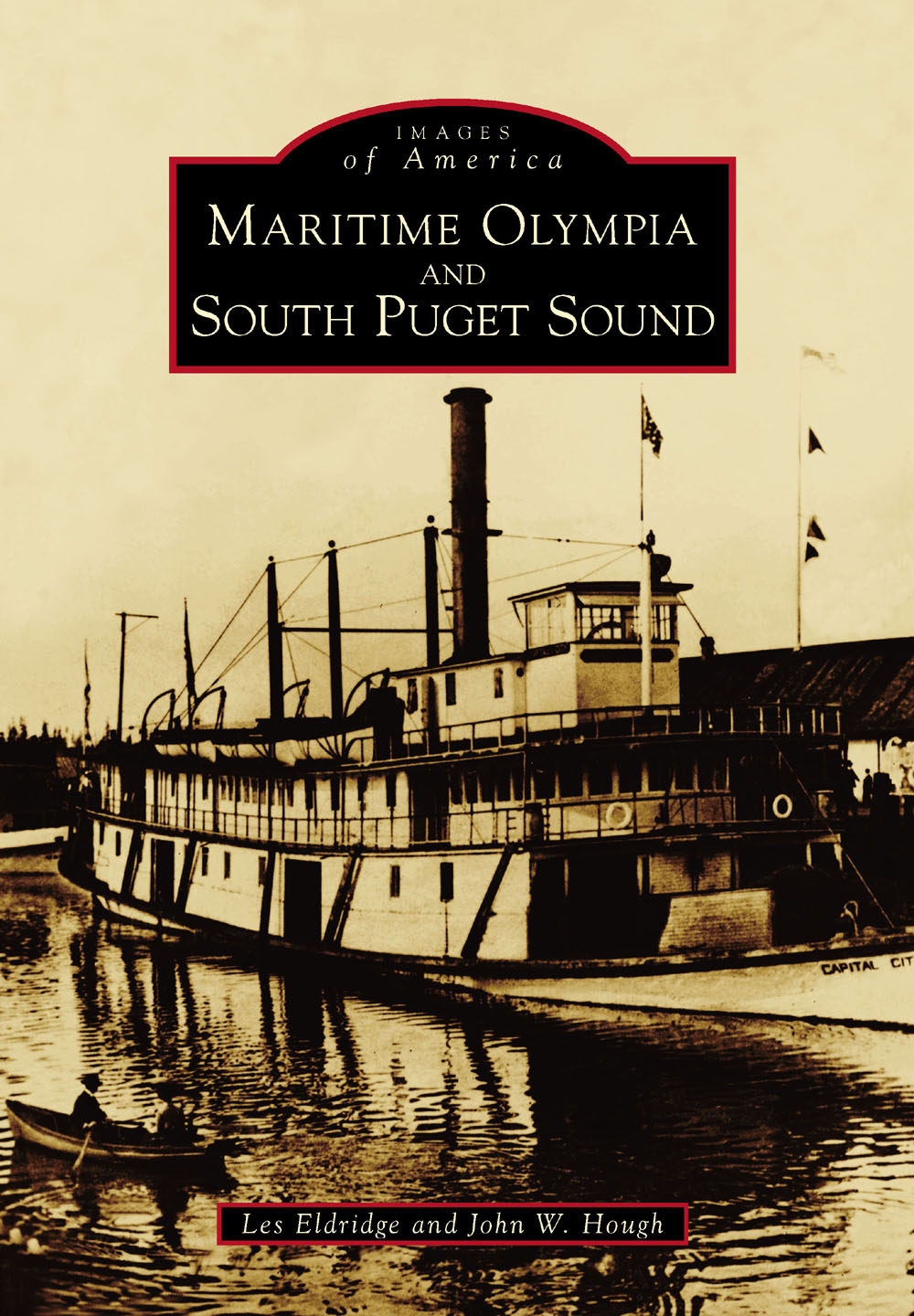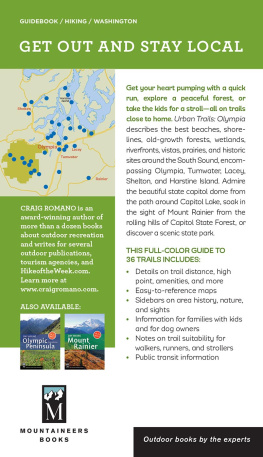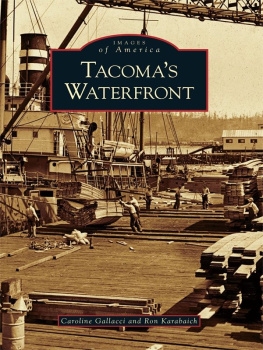
IMAGES
of America
MARITIME OLYMPIA
AND
SOUTH PUGET SOUND
ON THE COVER: The steamer Capital City sits at Percival Dock in Olympia while another vessel arrives at the busy port around 1900. Olympia was a major stop for scores of similar vessels of the Mosquito Fleet, which swarmed around Puget Sound carrying passengers and freight during the mid-1800s to the early 1900s. (Courtesy of Washington State Archives.)
IMAGES
of America
MARITIME OLYMPIA
AND
SOUTH PUGET SOUND
Les Eldridge and John W. Hough

Copyright 2017 by Les Eldridge and John W. Hough
ISBN 978-1-4671-2535-2
Ebook ISBN 9781439660614
Published by Arcadia Publishing
Charleston, South Carolina
Library of Congress Control Number: 2016953990
For all general information, please contact Arcadia Publishing:
Telephone 843-853-2070
Fax 843-853-0044
E-mail
For customer service and orders:
Toll-Free 1-888-313-2665
Visit us on the Internet at www.arcadiapublishing.com
To the master mariners who plied South Puget Sound and to the late Robin Paterson, longtime president of the International Retired Tugboat Association, who spent a lifetime preserving the memories of Puget Sound tugs and Mosquito Fleet steamers
CONTENTS
ACKNOWLEDGMENTS
We thank the many helpful professionals at the following institutions who provided us with information and guided us in locating many of their photographs in this book: Port of Olympia; Museum of History and Industry, Seattle (MOHAI); Olympia Tumwater Foundation; Tacoma Public Library; University of Washington Libraries, Special Collections; and Washington State Archives. We also cannot thank enough Deborah Haskett, who generously gave us access to the personal collection of historic maritime photographs assembled by her and her late husband, noted marine artist Patrick Haskett, and Kae Paterson, who graciously shared with us her late husband Robins extensive photograph collection of anything that floats.
We tip our hat to Chuck Fowler, award-winning Northwest maritime historian and author of several Arcadia books, for guiding us along the way, and to Patrick Eldridge, of Seattle Media Lab, who lent his graphic and computer skills to his dads project. Also, this book only came together with the invaluable advice and counsel of our ever-patient editor Henry Clougherty at Arcadia. We also thank the production staff at Arcadia for turning our poor efforts into this wonderful book.
We cannot go without extending our thanks to our wonderful wives, Mary Eldridge and Cindy Hough, for their loving patience and support throughout this project. We could not have done it without you.
All photographs in are courtesy of Port of Olympia unless otherwise noted.
INTRODUCTION
Olympia, Washington states capital, is located at the southern tip of Puget Sound.
This inland sea was carved out during the last ice age by a massive ice sheet that left a deep basin when it retreated. The entry into South Puget Sound is a narrow channel of swift currents between Tacoma and the Kitsap Peninsula that opens into a string of emerald islands leading up the sound to Olympia. The capital city has grown into the major port for southwestern Washington, but for millennia before Anglo-European explorers, traders, and settlers arrived, the resource rich waters of South Puget Sound had been home to Coast Salish people.
The indigenous people of South Puget Sound were accomplished voyagers. They used canoes carved out of huge cedar trees to fish for salmon, travel to prized clam and oyster beaches, and trade among themselves and with their Coast Salish neighbors to the north.
The first Europeans to encounter these intrepid mariners were British captain George Vancouver and his naval expedition in May 1792. Vancouver anchored near the future site of Seattle and sent 2nd Lt. Peter Puget, sailing master (navigator) Joseph Whidbey, and naturalist Archibald Menzies south of the Narrows to chart the unknown inlet. They failed to find a possible passage across the continent but in exploring the winding passages among the islands created detailed charts of the inlet. Vancouver honored Puget by naming the southern inlet Pugets Sound.
The British continued to explore the region. In November 1824, a 48-man Hudsons Bay Company (HBC) brigade ventured north from Fort George (later Astoria) on the Columbia River. As a result of its trip through the resource rich area, HBC established Fort Nisqually, the site now inside todays town of DuPont. The HBC outpost became a major trading center for South Puget Sound.
Americans first arrived in 1841 with the US Exploring Expedition, commanded by US Navy lieutenant Charles Wilkes. He and his men created very detailed charts of the South Sound and placed numerous names on geographical features in the sound, including the names of two of his officers: Olympias Budd Inlet (Lt. Thomas Budd) and adjacent Eld Inlet (Midshipman Henry Eld). His detailed charts and naming in the sound were factored in the international boundary being set at the 49th parallel in the 1846 negotiations between the United States and Great Britain.
An extraordinary assembly of seagoing scientists accompanied these early visits to South Puget Sound. George Vancouvers naturalist and physician, Archibald Menzies, collected many plants and named the Pacific Northwests ubiquitous Douglas fir after his colleague David Douglas. Scientists affiliated with the Hudsons Bay Company enhanced the world of botany and zoology. The Wilkes Expedition included 11 scientists whose specimen collections around the world from 1838 to 1842 caused the Smithsonian Institution to build its iconic Castle to house many thousand items of science.
These hardy, venturesome explorers and traders opened wide the door to South Sound settlement. Americans settlers began flowing into Oregon country, eventually displacing the HBC. In 1853, Oregon became a state, Washington Territory was created, and Olympia named its capital.
Thick, verdant forests ringed Puget Sound. In the absence of roads among communities, a marine transportation system evolved, beginning in the 1850s and not ending until the advent of the automobile and decent roads in the 1920s. Hundreds of small steamships moved goods and people among the villages and towns along the sound. Olympia was the southern terminus of the web of steamship routes that extended to every corner of the inland sea.
The small steamers churning and buzzing around Puget Sound earned the title Mosquito Fleet. Colorful, competitive captains raced at every opportunity, striving for reputation as the fastest boat along the water highway. Owners engaged in rate wars, undercutting each others prices to gain a bigger share of the passenger market. Propelled initially by stern-wheel and side-wheel paddles and later by screw propellers, the Mosquito Fleet engendered the construction of docks, shipyards, and navigation-dependent businesses. These vessels were the splendid vehicles on the Puget Sound and still live vividly in the memory of old-timers.
Sailing cargo vessels and Mosquito Fleet steamers served a growing Olympia, but mudflats that pushed out into Budd Inlet deterred larger oceangoing steamers from calling at the capital city. At the turn of the 20th century, extensive dredging deepened the harbor and created new uplands to provide a practical ocean-wide outlet for local goods.
Timber products were, and are today, a major portion of the Olympia areas economy. By 1922, there were 30 lumber mills, five shingle mills, and a veneer plant on the shoreline near Olympia. In addition, local farms grew a wide variety of berries, which were canned for shipment. Olympia Beer, brewed in nearby Tumwater, and succulent Olympia oysters were also shipped to customers worldwide.
Next page









